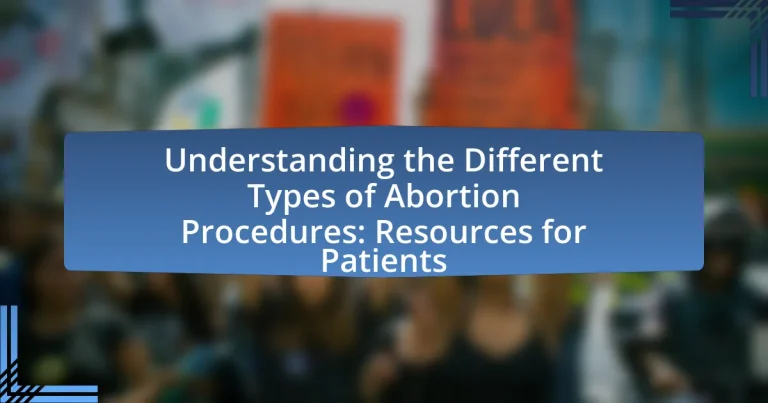The article provides a comprehensive overview of various abortion procedures, including medication abortion, aspiration abortion, dilation and curettage (D&C), and dilation and evacuation (D&E). It outlines the differences between medical and surgical abortions, detailing the medications used and the steps involved in each method. Additionally, the article discusses factors influencing the choice of procedure, such as gestational age and health conditions, as well as potential risks and complications associated with each option. Resources for patients, including counseling services and support groups, are also highlighted to assist individuals in making informed decisions and coping with their experiences.

What are the different types of abortion procedures?
There are several types of abortion procedures, including medication abortion, aspiration (suction) abortion, dilation and curettage (D&C), and dilation and evacuation (D&E). Medication abortion involves taking pills to terminate a pregnancy, typically within the first 10 weeks. Aspiration abortion uses suction to remove the contents of the uterus and is usually performed in the first trimester. D&C is a surgical procedure that scrapes the uterine lining and is often used for miscarriages or abortions. D&E is a more complex procedure used in the second trimester, involving dilation of the cervix and removal of fetal tissue. Each method has specific indications and is chosen based on gestational age and individual circumstances.
How do medical abortions differ from surgical abortions?
Medical abortions differ from surgical abortions primarily in their methods of termination. Medical abortions utilize medications, typically mifepristone followed by misoprostol, to induce a miscarriage, while surgical abortions involve a procedure to physically remove the contents of the uterus, such as suction aspiration or dilation and curettage (D&C). According to the World Health Organization, medical abortions can be performed up to 10 weeks into a pregnancy, whereas surgical abortions can be performed later, depending on the method and local regulations.
What medications are used in medical abortions?
The medications used in medical abortions are mifepristone and misoprostol. Mifepristone, taken first, blocks the hormone progesterone, which is necessary for pregnancy continuation. Misoprostol is taken subsequently to induce contractions and expel the pregnancy tissue. Clinical studies have shown that this combination is effective in terminating early pregnancies, with success rates exceeding 95% when used within the first 10 weeks of gestation.
What are the steps involved in a medical abortion?
A medical abortion typically involves two main steps: the administration of mifepristone followed by misoprostol. First, mifepristone is taken, which blocks the hormone progesterone necessary for pregnancy continuation. This is usually done in a healthcare setting. After 24 to 48 hours, the second medication, misoprostol, is taken either orally or vaginally, leading to uterine contractions that expel the pregnancy. This method is effective in over 95% of cases within the first 10 weeks of pregnancy, according to the World Health Organization.
What are the various surgical abortion methods available?
The various surgical abortion methods available include suction aspiration (also known as suction curettage), dilation and curettage (D&C), dilation and evacuation (D&E), and induction abortion. Suction aspiration is the most common method, typically performed in the first trimester, where a suction device removes the pregnancy tissue from the uterus. D&C involves scraping the uterine lining to remove tissue and is also used in early pregnancy. D&E is generally performed in the second trimester and involves dilating the cervix and using surgical instruments to remove the fetus and placenta. Induction abortion involves administering medication to induce labor and is used in later stages of pregnancy. These methods are supported by clinical guidelines and are performed by trained healthcare professionals to ensure safety and efficacy.
What is the process of suction aspiration?
Suction aspiration is a medical procedure used to terminate a pregnancy by removing the contents of the uterus through suction. During this process, a healthcare provider inserts a thin tube called a cannula into the uterus after dilating the cervix. The cannula is connected to a suction device that creates a vacuum, effectively extracting the uterine contents, including the embryo or fetus and surrounding tissue. This method is commonly performed in the first trimester and is known for being quick and generally safe, with a low risk of complications when conducted by trained professionals.
How does dilation and curettage (D&C) work?
Dilation and curettage (D&C) is a medical procedure that involves the dilation of the cervix and the scraping or suctioning of the uterine lining. During the procedure, a healthcare provider first dilates the cervix to allow instruments to enter the uterus. Then, using a curette or suction device, the provider removes tissue from the uterine lining, which may be necessary for various reasons, including abortion, miscarriage management, or diagnostic purposes. D&C is typically performed under local or general anesthesia, ensuring patient comfort and safety during the process.
What is dilation and evacuation (D&E) and when is it used?
Dilation and evacuation (D&E) is a surgical procedure used to terminate a pregnancy, typically performed during the second trimester. This method involves dilating the cervix and using surgical instruments to remove the contents of the uterus. D&E is commonly utilized when a woman has a pregnancy that is no longer viable, or when there are significant health risks to the woman or fetus. According to the American College of Obstetricians and Gynecologists, D&E is considered a safe and effective option for abortion during this stage of pregnancy.

What factors should patients consider when choosing an abortion procedure?
Patients should consider several factors when choosing an abortion procedure, including gestational age, type of procedure, medical history, and personal preferences. Gestational age is crucial as it determines the available options; for instance, medication abortion is typically available up to 10 weeks of pregnancy, while surgical options may be considered later. The type of procedure, whether medical or surgical, impacts recovery time and potential side effects, with medical abortions often allowing for privacy and comfort at home. Medical history, including any pre-existing conditions or allergies, influences the safety and suitability of specific procedures. Lastly, personal preferences regarding the experience, support systems, and emotional readiness play a significant role in the decision-making process. These considerations ensure that patients make informed choices aligned with their health needs and circumstances.
How do gestational age and health conditions influence the choice of procedure?
Gestational age and health conditions significantly influence the choice of abortion procedure. As gestational age increases, the options for abortion procedures may become limited; for instance, medical abortions are typically available up to 10 weeks of gestation, while surgical options like dilation and evacuation (D&E) are often recommended for later stages. Health conditions, such as pre-existing medical issues or complications during pregnancy, can also dictate the safest and most effective procedure, as certain conditions may necessitate a specific approach to minimize risks. For example, a patient with a bleeding disorder may require a different surgical technique to ensure safety. Thus, both gestational age and health conditions are critical factors in determining the appropriate abortion procedure.
What is the significance of gestational age in abortion procedures?
Gestational age is significant in abortion procedures because it determines the methods available and the legal restrictions that may apply. Different abortion methods, such as medication abortion and surgical abortion, are typically recommended based on how far along the pregnancy is, with medication abortion generally being effective up to 10 weeks of gestation. Additionally, many jurisdictions impose legal limits on when an abortion can be performed, often correlating with gestational age, which can affect access to care. For instance, in the United States, some states have laws prohibiting abortions after a certain number of weeks, commonly around 20 weeks, reflecting the importance of gestational age in both medical and legal contexts.
How do pre-existing health conditions affect the procedure choice?
Pre-existing health conditions significantly influence the choice of abortion procedure. Conditions such as cardiovascular disease, diabetes, or autoimmune disorders can complicate the safety and efficacy of certain procedures. For instance, patients with cardiovascular issues may be advised against surgical abortions due to the potential for increased stress on the heart during the procedure. Additionally, individuals with diabetes may require careful monitoring and adjustments in their care plan during medical abortions to manage blood sugar levels effectively. Medical guidelines, such as those from the American College of Obstetricians and Gynecologists, emphasize the importance of evaluating a patient’s overall health status to determine the most appropriate and safest abortion method.
What are the potential risks and complications associated with each procedure?
The potential risks and complications associated with abortion procedures include infection, heavy bleeding, damage to the uterus or cervix, and complications from anesthesia. Infection can occur in about 1-3% of cases, leading to serious health issues if untreated. Heavy bleeding, defined as losing more than two tablespoons of blood, can happen in approximately 1-2% of procedures, necessitating further medical intervention. Damage to the uterus or cervix, while rare, can occur in less than 1% of cases, potentially requiring surgical repair. Anesthesia complications, although infrequent, can arise, particularly in patients with pre-existing health conditions. Each type of abortion procedure, whether medical or surgical, carries these risks, which patients should discuss with their healthcare provider to make informed decisions.
What are the common side effects of medical abortions?
Common side effects of medical abortions include cramping, bleeding, nausea, vomiting, diarrhea, and fatigue. These effects occur as the body responds to the medications used to terminate the pregnancy. Research indicates that approximately 90% of women experience cramping, while about 50% report heavy bleeding. Nausea and vomiting can affect around 30% of patients, and fatigue is also frequently reported. These side effects typically resolve within a few days to a week after the procedure.
What complications can arise from surgical abortions?
Surgical abortions can lead to several complications, including infection, heavy bleeding, injury to the uterus or surrounding organs, and incomplete abortion. Infection can occur in approximately 1-3% of cases, leading to fever and abdominal pain. Heavy bleeding may require medical intervention in about 1-2% of surgical abortions. Injury to the uterus or nearby organs, while rare, can happen in less than 1% of procedures, potentially necessitating further surgery. Incomplete abortion, where some tissue remains in the uterus, can occur in about 1-5% of cases, requiring follow-up care. These statistics highlight the potential risks associated with surgical abortion procedures.

What resources are available for patients considering abortion?
Patients considering abortion have access to various resources, including healthcare providers, counseling services, and informational websites. Healthcare providers, such as clinics and hospitals, offer medical consultations and procedures, ensuring patients receive professional guidance tailored to their needs. Counseling services provide emotional support and help patients navigate their options, often available through local health departments or nonprofit organizations. Informational websites, such as Planned Parenthood and the Guttmacher Institute, offer comprehensive details about abortion procedures, legal rights, and financial assistance, empowering patients with knowledge to make informed decisions. These resources collectively support patients in understanding their choices and accessing necessary care.
Where can patients find reliable information about abortion procedures?
Patients can find reliable information about abortion procedures through reputable medical organizations, such as the American College of Obstetricians and Gynecologists (ACOG) and Planned Parenthood. These organizations provide evidence-based resources, including detailed descriptions of various abortion methods, safety information, and access to healthcare providers. ACOG, for instance, publishes clinical guidelines and educational materials that are regularly updated to reflect the latest research and best practices in reproductive health. Planned Parenthood offers comprehensive information on abortion services, including FAQs and support resources, ensuring patients have access to accurate and trustworthy information.
What online resources provide accurate information on abortion?
Planned Parenthood is a primary online resource that provides accurate information on abortion, including details about different procedures, health implications, and legal aspects. Their website offers comprehensive educational materials, including FAQs, articles, and videos that are regularly updated to reflect current medical guidelines and legal standards. The Guttmacher Institute is another reputable source, providing research and policy analysis on reproductive health, including abortion statistics and trends. Additionally, the World Health Organization (WHO) offers global guidelines and evidence-based information on safe abortion practices. These resources are widely recognized for their reliability and are frequently cited in academic and medical literature.
How can healthcare providers assist patients in understanding their options?
Healthcare providers can assist patients in understanding their options by offering clear, comprehensive information about different abortion procedures. This includes explaining the types of procedures available, such as medication abortion and in-clinic options, along with their benefits, risks, and what to expect during and after the process. Providers can utilize educational materials, such as brochures and videos, to enhance understanding. Additionally, they can engage in open discussions, allowing patients to ask questions and express concerns, which fosters a supportive environment for informed decision-making. Research indicates that when patients receive thorough information and support, they are more likely to feel confident in their choices regarding abortion procedures.
What support services are available for patients post-abortion?
Support services available for patients post-abortion include counseling, medical follow-up care, and support groups. Counseling services provide emotional support and help patients process their experiences, while medical follow-up care ensures physical health and addresses any complications. Support groups offer a community for sharing experiences and feelings, fostering a sense of belonging and understanding among individuals who have undergone similar situations. These services are often provided by healthcare facilities, non-profit organizations, and community health centers, ensuring that patients have access to the necessary resources for their recovery.
What counseling services can help patients cope with their experience?
Counseling services that can help patients cope with their experience include individual therapy, group therapy, and support groups specifically focused on reproductive health. Individual therapy provides personalized support, allowing patients to explore their feelings and experiences in a safe environment. Group therapy offers a shared space for individuals to connect with others who have similar experiences, fostering a sense of community and understanding. Support groups, often facilitated by trained professionals, provide ongoing emotional support and resources for coping strategies. Research indicates that these counseling services can significantly reduce feelings of isolation and improve emotional well-being among patients navigating abortion experiences.
How can patients connect with support groups after an abortion?
Patients can connect with support groups after an abortion by seeking out local or online resources specifically designed for post-abortion support. Organizations such as the National Abortion Federation and Post-Abortion Support International provide directories of support groups and counseling services. Additionally, social media platforms and community health centers often host or can direct individuals to support groups tailored for those who have experienced abortion, ensuring access to shared experiences and emotional support.
What are the best practices for patients preparing for an abortion procedure?
Patients preparing for an abortion procedure should follow several best practices to ensure a safe and informed experience. First, patients should schedule a consultation with a healthcare provider to discuss options, potential risks, and the procedure itself. This consultation allows for personalized medical advice and addresses any concerns.
Second, patients should review and understand the different types of abortion procedures available, such as medication abortion and in-clinic procedures, to make an informed choice. Research indicates that understanding the procedure can reduce anxiety and improve satisfaction with the decision (American College of Obstetricians and Gynecologists).
Third, patients should arrange for transportation to and from the appointment, as some procedures may require sedation or anesthesia. Additionally, patients should consider having a support person accompany them for emotional support.
Lastly, patients should follow any pre-procedure instructions provided by their healthcare provider, such as dietary restrictions or medication adjustments, to ensure their safety during the procedure. Following these best practices can lead to a more positive experience and better health outcomes.


